The looming threat of a government shutdown has raised concerns across numerous social programs, notably Supplemental Nutrition Assistance Program (SNAP) benefits, commonly known as food stamps. If federal agencies are forced to close due to funding lapses, millions of Americans who rely on SNAP could face interruptions in their assistance. While some benefits are typically issued in advance or through emergency measures, the potential for delays or reductions in aid remains a pressing issue for vulnerable populations. This uncertainty extends beyond immediate food security, risking increased strain on local food banks and charitable organizations. The situation underscores the broader implications of federal funding disputes, especially on programs designed to support low-income households. As negotiations continue, stakeholders are closely monitoring whether emergency provisions will be enacted to mitigate the impact on SNAP recipients.
Understanding How a Shutdown Could Disrupt SNAP Benefits
Funding and Benefit Disbursement Processes
The SNAP program is administered jointly by the U.S. Department of Agriculture (USDA) and state agencies. Typically, benefits are issued monthly, with many states providing funds early in anticipation of federal funding timelines. However, during a government shutdown, the USDA’s Food and Nutrition Service (FNS) could face staffing shortages and operational delays, potentially disrupting the distribution process. Some states have contingency plans to issue benefits through emergency funds or reserve accounts, but these are not guaranteed to cover all recipients or sustain the program for extended periods.
Emergency Measures and Contingency Plans
Historically, in the face of federal funding shortfalls, the USDA has occasionally authorized temporary measures to ensure continuous access to benefits. These include issuing emergency allotments or extending current benefits beyond their normal expiration dates. Nonetheless, the extent and duration of such measures depend on congressional action and administrative decisions. Without immediate intervention, recipients might experience delays in receiving their monthly benefits, which could jeopardize access to essential nutrition for vulnerable households.
Impact on SNAP Recipients and Food Security
Potential Effects on Low-Income Families
- Reduced Purchasing Power: Any delays or reductions in benefits directly decrease families’ ability to purchase nutritious food, heightening food insecurity.
- Increased Reliance on Charitable Organizations: Food banks and community organizations may see a surge in demand as families seek alternative sources of assistance.
- Health and Well-being Concerns: Interrupted access to proper nutrition can lead to adverse health effects, especially among children, seniors, and individuals with chronic illnesses.
States Most Vulnerable to Disruption
States with higher proportions of SNAP recipients, such as Mississippi, Louisiana, and New Mexico, could experience more pronounced effects. These regions often rely heavily on federal assistance, and any delays could exacerbate existing food insecurity issues. Local agencies may attempt to buffer the impact through state-funded programs, but resources are limited and vary widely.
Broader Economic and Social Implications
Effects on Local Economies
SNAP benefits inject billions into local economies annually, supporting grocery stores, farmers markets, and small businesses. A disruption in benefit distribution could slow economic activity in regions heavily dependent on federal assistance. A decline in consumer spending may ripple through local supply chains, affecting employment and community stability.
Government’s Role and Legislative Response
Congress has the authority to pass legislation to fund the government temporarily or to allocate emergency funds specifically for SNAP. Past shutdowns, such as those in 2013, prompted swift legislative action to prevent large-scale disruptions. However, ongoing political disagreements may delay such measures, leaving millions of Americans in limbo.
Resources and How to Prepare
| Agency / Resource | Contact / Link |
|---|---|
| USDA Food and Nutrition Service | https://www.fns.usda.gov |
| State SNAP Offices | Find local contacts on your state government website |
| Local Food Banks and Charities | Visit Feeding America’s website for local resources: https://www.feedingamerica.org |
Precautionary Steps for Recipients
- Review your current SNAP balance and understand your next benefit issuance date.
- Stockpile non-perishable foods and essentials where possible.
- Stay informed through official government channels and local news for updates on the shutdown status.
- Explore community resources and local food assistance programs as a contingency plan.
Looking Ahead
While the immediate concern centers on the potential disruption of SNAP benefits, the longer-term implications hinge on legislative action. Lawmakers face the challenge of balancing budget priorities with the critical needs of millions of Americans who depend on federal assistance programs for daily sustenance. The outcome will determine whether vulnerable populations face hardship or if emergency measures can bridge the gap during a government shutdown. As discussions continue, advocates urge swift resolution to protect food security and prevent avoidable hardships for low-income families across the nation.
Frequently Asked Questions
What is the potential impact of a government shutdown on SNAP benefits?
A government shutdown could temporarily disrupt SNAP benefits distribution, potentially causing delays in food stamp assistance payments to eligible recipients.
Will SNAP recipients continue to receive benefits during a shutdown?
In many cases, SNAP benefits are funded through existing federal reserves, which may allow recipients to continue receiving assistance for a limited period. However, prolonged shutdowns could jeopardize future payments.
How might a government shutdown affect food assistance programs beyond SNAP?
Other food assistance programs, such as school meal programs and nutrition assistance for vulnerable populations, could also face disruptions or reduced funding during a government shutdown.
Are there any measures in place to protect SNAP benefits during a shutdown?
Some federal agencies may have funds or emergency measures to protect SNAP benefits temporarily, but these are not guaranteed and depend on the duration of the shutdown.
What should SNAP beneficiaries do if their benefits are delayed?
If benefits are delayed, recipients should contact their local food assistance offices for guidance and explore emergency food resources available in their community.








